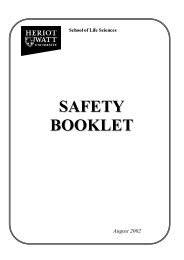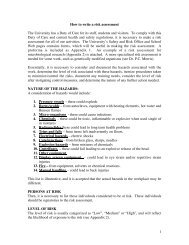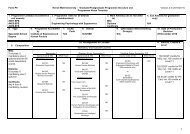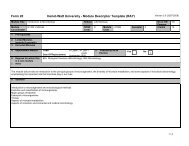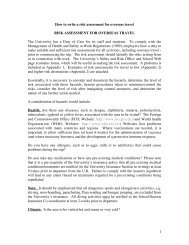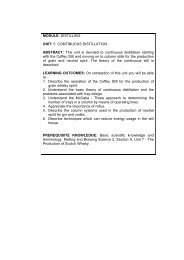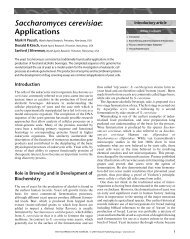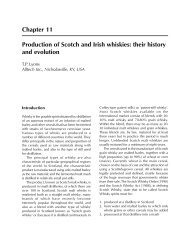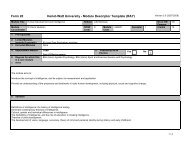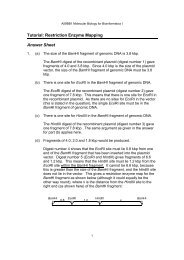Big Five Factors of Personality and Replicated Predictions of Behavior
Big Five Factors of Personality and Replicated Predictions of Behavior
Big Five Factors of Personality and Replicated Predictions of Behavior
You also want an ePaper? Increase the reach of your titles
YUMPU automatically turns print PDFs into web optimized ePapers that Google loves.
414 PAUNONEN<br />
Purpose <strong>of</strong> This Study<br />
I have two primary goals in this study. First, despite the argument<br />
I advanced above that there are predictive benefits to using<br />
<strong>Big</strong> <strong>Five</strong> facets <strong>of</strong> personality over <strong>Big</strong> <strong>Five</strong> factors as predictors<br />
<strong>of</strong> complex criteria, it is nevertheless important to demonstrate that<br />
the latter also have some utility in that regard. Furthermore, as<br />
mentioned earlier, different (construct valid) measures <strong>of</strong> the same<br />
factors should show some agreement in the variables they are able<br />
to predict. Because I administered three different measures <strong>of</strong> the<br />
<strong>Big</strong> <strong>Five</strong> in this study <strong>and</strong> because I assessed many socially<br />
important criterion variables, I was able to evaluate these requisites<br />
<strong>of</strong> measurement validity in this research. Although some <strong>of</strong> the<br />
studies I have already cited have demonstrated predictive utility to<br />
certain <strong>Big</strong> <strong>Five</strong> factor measures, no study has yet applied such a<br />
st<strong>and</strong>ard <strong>of</strong> replication as I describe below to the prediction <strong>of</strong> such<br />
a large set <strong>of</strong> complex behaviors.<br />
My second goal in this study, related to the first, is to provide<br />
further evidence <strong>of</strong> convergent validity for the new nonverbal <strong>Big</strong><br />
<strong>Five</strong> questionnaire, the FF–NPQ. New measures <strong>of</strong> personality are<br />
required to show some degree <strong>of</strong> correlation with established<br />
measures <strong>of</strong> the same traits. This study provides me with an<br />
opportunity to evaluate this aspect <strong>of</strong> the FF–NPQ’s construct<br />
validity by comparing the nonverbal <strong>Big</strong> <strong>Five</strong> scales against corresponding<br />
verbal <strong>Big</strong> <strong>Five</strong> scales.<br />
Participants<br />
Method<br />
I administered measures <strong>of</strong> personality factors <strong>and</strong> behavior criteria to<br />
two different samples <strong>of</strong> university students. The first sample consisted <strong>of</strong><br />
276 introductory psychology students (152 men <strong>and</strong> 124 women), <strong>and</strong> the<br />
second sample consisted <strong>of</strong> 142 introductory psychology students (56 men<br />
<strong>and</strong> 86 women). Although I analyzed the data separately by sample, I<br />
discuss them together in terms <strong>of</strong> the consistencies <strong>of</strong> particular <strong>Big</strong> <strong>Five</strong><br />
factors in predicting specific criterion variables.<br />
Materials<br />
The FF–NPQ. Both samples <strong>of</strong> participants completed the FF–NPQ,<br />
which has already been described in the introduction. This questionnaire is<br />
a 60-item measure <strong>of</strong> the <strong>Big</strong> <strong>Five</strong> personality factors, with 12 nonverbal<br />
items on each factor scale. The items consist <strong>of</strong> pictorial depictions <strong>of</strong><br />
personality-relevant behaviors being performed in specific situations. Respondents<br />
rate the likelihood that they would engage in the types <strong>of</strong><br />
behaviors illustrated using 7-point rating scales (see Figure 1).<br />
The NEO–FFI <strong>and</strong> NEO–PI–R. One sample <strong>of</strong> participants completed<br />
the NEO–FFI, whereas the other sample completed the NEO–PI–R. Although<br />
both inventories are measures <strong>of</strong> the <strong>Big</strong> <strong>Five</strong> personality factors,<br />
the former is a 60-item questionnaire, <strong>and</strong> the latter is a 240-item questionnaire.<br />
The NEO–FFI was constructed to measure the five factors<br />
with 12 items each. The much longer NEO–PI–R consists <strong>of</strong> 30 eight-item<br />
facet scales, 6 <strong>of</strong> which are summed to derive each <strong>of</strong> the <strong>Big</strong> <strong>Five</strong> factor<br />
measures. The items on both inventories are rated by respondents on<br />
5-point scales. Note that the 60 items <strong>of</strong> the NEO–FFI constitute a subset<br />
<strong>of</strong> the 240 items in the NEO–PI–R.<br />
The <strong>Behavior</strong> Report Form. All participants completed the <strong>Behavior</strong><br />
Report Form, which is a measure I designed to assess several complex<br />
behaviors <strong>of</strong> some social significance. I first used it in Paunonen (1993)<br />
<strong>and</strong> Paunonen (1998) <strong>and</strong> later exp<strong>and</strong>ed <strong>and</strong> revised it (Paunonen &<br />
Ashton, 2001a). The four separate pages <strong>of</strong> the <strong>Behavior</strong> Report Form are<br />
reproduced in the Appendix. For the present analysis, I transformed a few<br />
<strong>of</strong> the behaviors measured by that form somewhat, for reasons that become<br />
apparent below (e.g., for Item 18, the total <strong>of</strong> all medications taken<br />
regularly was computed). I also omitted a few variables because <strong>of</strong> excessive<br />
missing data (e.g., for Item 12, almost no students were members <strong>of</strong><br />
a fraternity) or highly skewed data (e.g., for Item 20, very few students<br />
worked many hours at a part-time job). In addition, some variables were<br />
not analyzed because they did not represent behaviors as such (e.g., the<br />
rating <strong>of</strong> eyesight in Item 19) or were redundant with other variables (e.g.,<br />
in Item 9, the number <strong>of</strong> cigarettes smoked per day was highly redundant<br />
with the smoking behavior rating).<br />
The specific <strong>Behavior</strong> Report Form variables evaluated in this study <strong>and</strong><br />
used as behavior criteria number 27 in all. These criteria, with their labels<br />
in italics, include (1) self-perceived attractiveness, (2) self-perceived intelligence,<br />
(3) self-perceived popularity, (4) self-perceived femininity, (5)<br />
self-perceived religiosity, (6) self-perceived honesty, (7) grade point average,<br />
(8) dating frequency as number <strong>of</strong> dates per month, (9) dating<br />
variety as number <strong>of</strong> different people dated over a year, (10) tobacco<br />
consumption as the 5-point rating <strong>of</strong> smoking behavior, (11) alcohol<br />
consumption as the 5-point rating <strong>of</strong> drinking behavior, (12) preference for<br />
a liberal arts program <strong>of</strong> study, (13) 9-point rating <strong>of</strong> interest in fraternity<br />
or sorority membership, (14) mean number <strong>of</strong> all traffic violations received<br />
per year, (15) driving fast as the maximum speed driving a car, (16) money<br />
spent buying lottery tickets per month, (17) number <strong>of</strong> parties attended per<br />
month, (18) having engaged in long-term dieting behavior, (19) total<br />
number <strong>of</strong> prescription medications used regularly, (20) preference for<br />
contacts over glasses as prescription lenses, (21) engaged in part-time<br />
work, (22) ability to play musical instruments, (23) participation in sports,<br />
(24) performing routine exercise, (25) donating blood occasionally, (26) an<br />
obesity index defined by weight/height 2 , <strong>and</strong> (27) participant sex or gender.<br />
(Sex was also used in this study as a covariate in analyses <strong>of</strong> the other<br />
criteria.) Note that four <strong>of</strong> the criteria listed above were computed variables,<br />
based on combinations <strong>of</strong> two or more <strong>Behavior</strong> Report Form items<br />
(i.e., Criteria 14, 19, 20, <strong>and</strong> 26).<br />
Note also that the first six criterion variables listed above are each<br />
qualified by the term self-perceived. This labeling is to highlight the fact<br />
that ratings on those variables do not necessarily reflect objective levels <strong>of</strong><br />
the nominal attributes (i.e., attractiveness, intelligence, popularity, femininity,<br />
religiosity, <strong>and</strong> honesty). Instead, those ratings are best thought <strong>of</strong><br />
in this study as representing behaviors related to the self-evaluation <strong>of</strong><br />
those physical or psychological characteristics that, for a variety <strong>of</strong> reasons,<br />
might not agree well with more objective assessments. To illustrate,<br />
self-perceived physical attractiveness could be a complexly determined<br />
belief, based on one’s interpersonal experiences, personal st<strong>and</strong>ard <strong>of</strong><br />
beauty, social comparison network, self-enhancement tendency, <strong>and</strong> so<br />
forth, including some element <strong>of</strong> objective beauty. This issue <strong>of</strong> selfperception<br />
versus objective assessment <strong>and</strong> the validity <strong>of</strong> the <strong>Behavior</strong><br />
Report Form variables is raised again in the Discussion section <strong>of</strong> this<br />
article.<br />
Procedure<br />
I administered the <strong>Big</strong> <strong>Five</strong> personality factor measures <strong>and</strong> the behavior<br />
criterion measures to the two samples <strong>of</strong> university undergraduates. The<br />
first sample (n 276) completed the FF–NPQ, the NEO–FFI, <strong>and</strong> the<br />
<strong>Behavior</strong> Report Form. Because <strong>of</strong> an oversight on the part <strong>of</strong> a research<br />
assistant, data were collected from only 178 <strong>of</strong> the respondents with the<br />
FF–NPQ. Also, 3 students failed to complete the NEO–FFI. The second<br />
sample (n 142) completed the FF–NPQ, the NEO–PI–R, <strong>and</strong> the <strong>Behavior</strong><br />
Report Form. Seven students in that sample failed to complete the<br />
NEO–PI–R.



